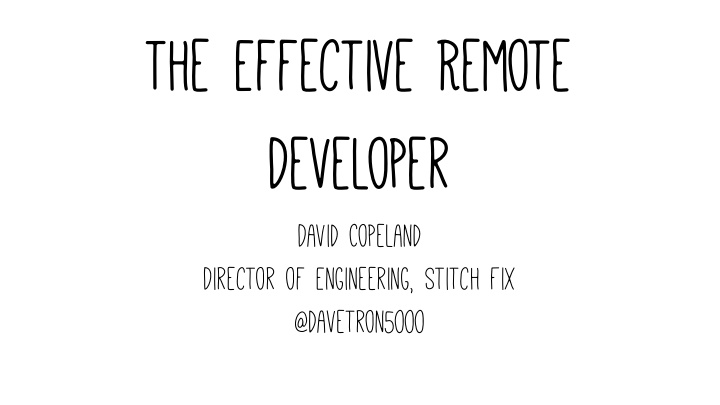



The Effective Remote Developer David Copeland Director of Engineering, Stitch Fix @davetron5000
4+ Years Remote • 3rd Developer at Stitch Fix • Work daily with developers, users, business people, vendors • 80+ developers: most work remotely
What do we mean “remote”?
“You Do Not Often Interact Face-To-Face With The People You Work With”
What is “Effective”? Producing Value Agency Inclusion Rewarding
You don’t get thESE for FREE being co-located but they are harder to achieve when REMOTE.
It’s not easy—it takes constant upkeep.
But, it’s worth it.
Freedom & Flexibility
Company has access to a wider pool of talent
Build & Maintain Trust
“The half-life of trust is six weeks” (it must be constantLY replenished) http://www.construx.com/10x_Software_Development/ Travel_Restrictions_and_Offshore_Development/
Four Mindsets to Build & Maintain Trust Communicate frequently & clearly Be responsive , but set boundaries Assume good intentions Help others help you
Base level of technology
Chat system that’s easy to use (so…not irc)
Video conference that supports multiple people (webex meets this standard :)
Non-shitty microphone (your laptop’s mic is shitty)
OK, back to trust
Coding Asynchronous synchronous Socializing
Coding
Communicate Frequently & Clearly • Turn big projects into smaller ones • Smallest viable change • Write great change requests • Learn to screencast , learn to diagram
Be Responsive, but Set Boundaries • Publicize your working hours • Watch for feedback…and respond ! • Avoid spending hours heads-down— develop SLAs for all forms of communication and responsiveness
Assume Good Intentions • Code review comments are cold & harsh • The reviewer is just trying to help
Help Others Help You • Go to chat or video • Communicate how they communicate best • Be specific in what feedback you want
Asynchronous Communication
Communicate Frequently & Clearly • Provide more context • Read what you write, learn to revise (at least once!) • Typography Matters • Learn (again) how to diagram
Be Responsive, but Set Boundaries • Engage and give feedback • Feedback leads to agency and cultivates leadership • Don’t forget affirming feedback!
Assume Good Intentions • Assume everyone is good at their job
Help Others Help You • Be specific in what feedback you want
synchronous Communication
Communicate Frequently & Clearly • Be prepared • Use nouns instead of pronouns • Pause and ask for feedback
Be Responsive, but Set Boundaries • Pay attention— don’t multitask • Jump in when you have something to say—don’t be afraid to backtrack • Yield the floor to others explicitly • Don’t be a jerk. Be self-aware and get feedback offline
Assume Good Intentions • Non-remotes aren’t accustomed to this • Don’t forget: computers are terrible and nothing works
Help Others Help You • Point out A/V problems, and be directive with solutions • Establish an ally or regular backchannel
Socializing
Communicate Frequently & Clearly • Make smalltalk • Have 1-1’s with no agenda
Be Responsive, but Set Boundaries • Establish clear travel expectations • Push yourself to travel to meet others in person
Assume Good Intentions • Ignorance isn’t a lack of consideration • Learn to be OK missing happy hours
Help Others Help You • Suggest ways for remotes to socialize • Arrange face time or meet ups—bring your boss a plan they just have to say “yes” to.
Trust
Four Mindsets to Build & Maintain Trust Communicate frequently & clearly Be responsive , but set boundaries Assume good intentions Help others help you
Thanks! • Work This way: http://multithreaded.stitchfix.com/careers • Contact Me: @davetron5000 http://www.naildrivin5.com • Learn More non-Coding Developer Life Skills: http://sweng.me
Recommend
More recommend